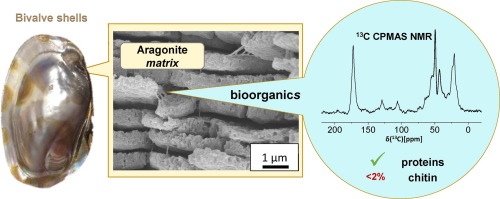Acta Biomaterialia ( IF 9.7 ) Pub Date : 2018-09-11 , DOI: 10.1016/j.actbio.2018.09.009 Oluwatoosin Bunmi A. Agbaje , Ira Ben Shir , David B. Zax , Asher Schmidt , Dorrit E. Jacob

|
Bivalve shells are inorganic-organic nanocomposites whose material properties outperform their purely inorganic mineral counterparts. Most typically the inorganic phase is a polymorph of CaCO3, while the organic phase contains biopolymers which have been presumed to be chitin and/or proteins. Identifying the biopolymer phase is therefore a crucial step in improving our understanding of design principles relevant to biominerals. In this work we study seven shells; four are examples of nacroprismatic shells (Alathyria jacksoni, Pinctada maxima, Hyriopsis cumingii and Cucumerunio novaehollandiae), one homogeneous (Arctica islandica), and two are crossed lamellar (Callista kingii, Tridacna gigas). Both intact shells, their organic extracts as isolated after decalcification in acid, and the periostracum overlay have been studied by solid-state CP-MAS NMR, FTIR, SEM and chemical analysis. In none of the shells examined in this work do we find a significant contribution to the organic fraction from chitin or its derivatives despite popular models of bivalve biomineralization which assume abundant chitin in the organic fraction of mollusc bivalve shells. In each of the nacroprismatic extracts the 13C NMR spectra represent similar proteinaceous material, Ala and Gly-rich and primarily organized as β-sheets. A different, yet highly conserved protein was found in the periostracum covering each of the three nacreous shells studied. The Arctica islandica shells with homogeneous microstructure contained proteins which do not appear to be silk-like, while in the crossed lamellar shells we extracted too little organic matter to characterize.
Statement of Significance
Hydrophobic macromolecules are structural components within the calcareous inorganic matrix of bivalve shells and are responsible for enhanced materials properties of the biominerals. Prevalent models suggest that chitin is such major hydrophobic component. Contrary to that we show that chitin is rare within the hydrophobic biopolymers which primarily consist of proteinaceous matter with structural motifs as silk-like β -sheets, or others yet to be determined. Recognizing that diverse proteinaceous motifs, devoid of abundant chitin, can yield the optimized mechanical properties of bivalve shells is critical both to understand the mechanistic pathways by which they regulate biomineralization and for the design of novel bioinspired materials.
中文翻译:

双壳壳内的生物大分子:甲壳质丰富吗?
双壳壳是无机-有机纳米复合材料,其材料性能优于纯无机矿物。最典型地,无机相是CaCO 3的多晶型物,而有机相包含据推测是几丁质和/或蛋白质的生物聚合物。因此,鉴定生物聚合物相是提高我们对与生物矿物相关的设计原理的理解的关键步骤。在这项工作中,我们研究了七个弹壳。四个是are棱壳的实例(Alathyria jacksoni,Pinctada maxima,Hyriopsis cumingii和Cucumerunio novaehollandiae),一个是均质的(Arctica islandica),两个是交叉的层状(卡莉丝塔kingii,砗)。通过固态CP-MAS NMR,FTIR,SEM和化学分析,研究了两个完整的壳,在酸中脱钙后分离出的有机提取物和骨灰石覆盖层。尽管双壳类生物矿化的流行模型假定软体动物双壳类壳的有机部分中富含甲壳质,但在这项工作中所研究的任何壳中,我们均未发现几丁质或其衍生物对有机部分具有显着贡献。在每个芥末提取物中,13 C NMR光谱代表相似的蛋白质物质,富含Ala和Gly,主要组织为β-张。在覆盖的三个珍珠质壳中的每个骨膜中发现了一种不同但高度保守的蛋白质。具有均匀微观结构的北极小岛壳中所含蛋白质似乎并不像丝一样,而在交叉的层状壳中,我们提取的有机物太少而无法表征。
重要声明
疏水大分子是双壳贝壳的钙质无机基质中的结构成分,负责增强生物矿物的材料性能。流行的模型表明,几丁质是这种主要的疏水成分。与此相反,我们表明几丁质在疏水性生物聚合物中很少见,而疏水性生物聚合物主要由具有结构图案如丝状β-片层或其他待确定的蛋白质物质组成。认识到缺乏丰富的几丁质的各种蛋白质基序可以产生双壳贝壳的最佳机械性能,这对于理解它们调控生物矿化的机理途径以及新型生物启发性材料的设计都是至关重要的。



























 京公网安备 11010802027423号
京公网安备 11010802027423号